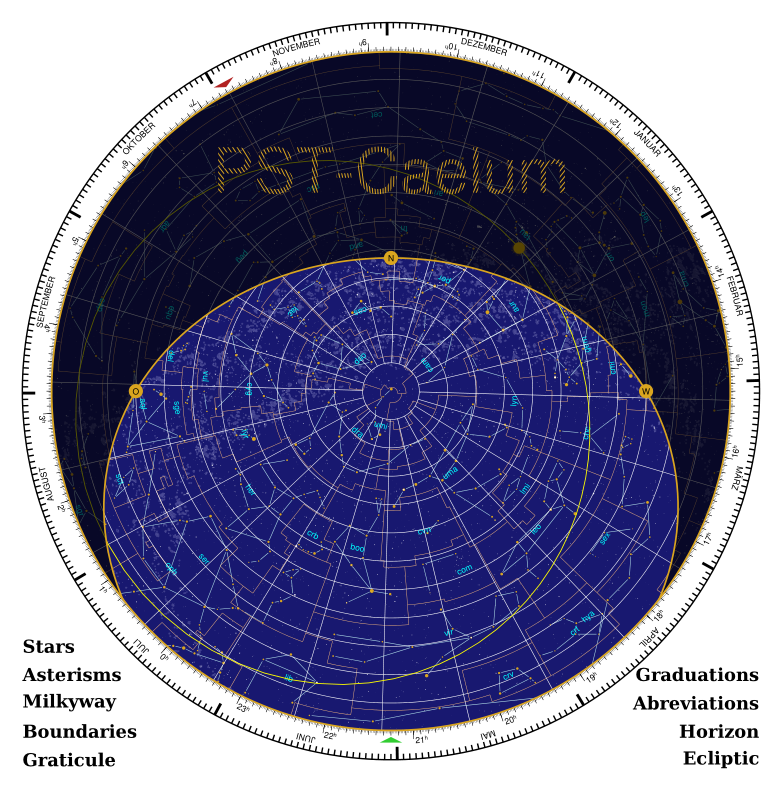
\documentclass[svgnames,a4paper]{standalone} \usepackage[T1]{fontenc} \usepackage[frenchb]{babel} \usepackage{bera} %% "xcolor" is loaded by "pstricks" already, which is required by "pst-caelum" ... %\usepackage{xcolor} \usepackage{pst-caelum} %% For setting OCGs (Layers) -- toggle them on/off via a link \usepackage{ocgx2} \begin{document} \begin{pspicture}(-7,-7)(7,7) %%%%%%%%%%%%%%%%%%%%%%%%%%%%%%%%%%%%%%%%%%%%%%%%%%%%% %%% GLOBAL SETTINGS %%% %%% see "pst-caelum.tex" for the default settings %%% %%%%%%%%%%%%%%%%%%%%%%%%%%%%%%%%%%%%%%%%%%%%%%%%%%%%% \psset[caelum]{% hemisphere=north, % north, south, local lang=de, % de, fr, en, it, es projection=pa, % pa, ps, pm, po, pl, dca, dcm, dcs % THESE PROJECTIONS ARE SIMPLY AMAZING!!! :-) EXCELLENT!!! horizon=north, % north, south altitude=0, % natural number (affects to \caelum{Horizon} to shrink it) lon=0, % longitude of the observer lat=47, % latitude of the observer year=2021, % Is there a limit for year < XXXX ??? % JMS: no, xint-meeus can calculate the position of the sun % and the sidereal time for a good number of years to come. month=6, % natural number of month: 1 = January, ..., 12 = December day=1, % natural number between 1 and 31 hour=21.25, % NOTE: minutes are done with decimals in "hour" %rotate=0, % No idea yet -- waiting for documentation % JMS: Rotate the map to place a region in the right place for a clip. %opacity=0, % makes sense for the \caelum{Horizon} is set locally %magmax=8, % Shows stars with max magnitude of 8 %scale=1, % scales objects also locally %size=1, % e.g. makes the dots of the Milkyway smaller/greater -- is set locally %abrev=and, % No idea yet -- waiting for documentation % JMS: Choose a constellation to draw by its abbreviation %starsonly=false, % boolean %segmentsonly=false, % boolean sideralrotation, % boolean %withsun, % boolean makes sense, if \caelum{Ecliptic} is set (set locally) } %%%%%%%%%%%%%%%%%%%%%%%%%%%%%%%%%%%%%%%%% %%% OBJECTS in the sky %%% %%% They can be changed individually. %%% %%% NOTE: The objects are treated %%% %%% like "layers" -- one set over %%% %%% the other -- so the order matters %%% %%%%%%%%%%%%%%%%%%%%%%%%%%%%%%%%%%%%%%%%% % REMARK: I setup % mostly after every line to avoid the spurious spaces % I am not sure to have gotten rid of all them %% SKY itself \caelum{Sky}% %% Sets the sky itself (color etc.) %% MILKYWAY \begin{ocg}{Milkyway}{myMilkyway}{1}% \caelum[color1={[rgb]{0.25 0.25 0.55}},color2={[rgb]{0.3,0.3,0.6}},size=0.25]{Milkyway}% %% Shows Milkyway \end{ocg}% %% OPTIONS: "color1=, color2=" set individual colors for the stars %% of the Milkyway %% "size=0.25" resizes the dots (stars) %% ASTERISMS \begin{ocg}{Asterisms}{myAsterisms}{1}% \caelum[linewidth=0.2pt,fillcolor=Goldenrod,size=1.4]{Asterisms}% %% Shows the figures in the sky \end{ocg}% \begin{ocg}{Stars}{myStars}{1}% %% OPTION: "size=1.4" resizes the dots (stars) of the figures \caelum[fillcolor=white]{Stars}% %% Shows many stars as a background layer \end{ocg}% \begin{ocg}{Boundaries}{myBoundaries}{1}% \caelum[linewidth=0.15pt,linecolor=orange!50]{Boundaries}% %% Shows boundaries of the constellations ("linestyle=dashed/dotted") \end{ocg}% %% HELPER %\caelum[linecolor=red,fillcolor=green,abrev=and]{Constellations} %% One chooses a constallation by its abreviation and highlights its boundary \begin{ocg}{Abreviations}{myAbreviations}{1}% \caelum[textcolor=cyan]{Abreviations}% %% NOTE: textcolor for text not linecolor: Shows abreviations of constellations \end{ocg}% \begin{ocg}{Graticule}{myGraticule}{1}% \caelum[linecolor=white,linewidth=0.2pt]{Graticule}% %% Shows degree lines \end{ocg}% \begin{ocg}{Graduations}{myGraduations}{1}% \caelum[linecolor=Black]{Graduations}% %% Ticks, ticks and ticks for hrs, min and months, days :-) SUPERBE !!! \end{ocg}% %% automatically sets green triangle for TU and red triangle for sideral time %% ADDITIONAL curves \begin{ocg}{Ecliptic}{myEcliptic}{1}% \caelum[linecolor=Yellow,linewidth=0.3pt,withsun]{Ecliptic}% %% Ecliptic curve of the sun \end{ocg}% %% OPTION: "withsun" sets an eps picture of the sun to the correct %% place on the ecliptic, depending on the date, hour used %\caelum[linewidth=0.3pt,linecolor=red]{EGalactic} %% Galactic equator -- same direction as Milkyway %\caelum[linewidth=0.5pt,linecolor=Green,linestyle=dashed]{Equator} %% Earth equator \begin{ocg}{Horizon}{myHorizon}{1}% \caelum[linecolor=Goldenrod,fillcolor=Black,opacity=0.65,linewidth=0.6pt]{Horizon}% %% OPTIONS: "altitude=5" shrinks more the horizon the larger the number \end{ocg}% %% "opacity=0.65" sets transparency to the out-of-horizon objects %%%%%%%%%%%%%%%%%%%%%%%%%%%%%%%%%%%%%%%% %%% Setting the links for the layers %%% %%%%%%%%%%%%%%%%%%%%%%%%%%%%%%%%%%%%%%%% \rput[l](-6.5,-4.5){% \switchocg{myStars}{\bfseries Stars}% } \rput[l](-6.5,-5){% \switchocg{myAsterisms}{\bfseries Asterisms}% } \rput[l](-6.5,-5.5){% \switchocg{myMilkyway}{\bfseries Milkyway}% } \rput[l](-6.5,-6){% \switchocg{myBoundaries}{\bfseries Boundaries}% } \rput[l](-6.5,-6.5){% \switchocg{myGraticule}{\bfseries Graticule}% } \rput[r](6.5,-5){% \switchocg{myGraduations}{\bfseries Graduations}% } \rput[r](6.5,-5.5){% \switchocg{myAbreviations}{\bfseries Abreviations}% } \rput[r](6.5,-6){% \switchocg{myHorizon}{\bfseries Horizon}% } \rput[r](6.5,-6.5){% \switchocg{myEcliptic}{\bfseries Ecliptic}% } \end{pspicture} \end{document}